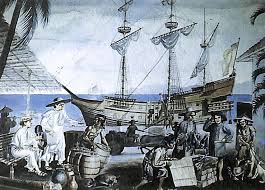In the late 1500s and early 1600s, Chinese demand for silver catalyzed the creation of the first truly global trade network. The Ming Dynasty’s reliance on silver as the backbone of its economy integrated economies across the Americas, Europe, and Asia, setting the stage for modern globalization. As silver flowed into China to satisfy its economic needs, goods like silk, porcelain, and tea flowed out, linking continents in an unprecedented system of exchange. This interconnected trade network, driven by Chinese demand, became a defining feature of the early modern era.

The Role of China’s Demand for Silver
- Silver as the Preferred Currency:
- The Ming Dynasty’s Single Whip Reform (1581) mandated that taxes and other payments be made in silver, creating an immense and steady demand for the metal.
- As China’s economy grew, silver became the standard for both domestic transactions and international trade.
- Luxury Goods for Silver:
- Chinese silk, porcelain, and tea were highly sought after in Europe and the Americas. These goods became symbols of wealth and status in the West, creating an enormous market for Chinese exports.
- In exchange, China required silver, which it did not produce in large quantities domestically, leading to a flow of the metal into Chinese coffers.
The First Truly Global Trade Network
- The Flow of Silver from the Americas to Asia:
- Spanish Silver Mines: Silver extracted from the massive mines at Potosí (Bolivia) and Zacatecas (Mexico) was shipped to Spain, where it entered European and Asian markets.
- The Manila Galleon Trade (1565–1815): Spanish galleons transported silver from Mexico to the Philippines, where it was exchanged for Chinese goods. The Philippines became a crucial hub connecting the Americas and Asia.
- European Intermediaries:
- European powers like Portugal, the Netherlands, and England played key roles in facilitating the trade.
- European merchants purchased Chinese goods with silver acquired from the Americas or through regional trade in Japan and Southeast Asia.
- Japan as a Silver Supplier:
- In addition to the Americas, Japan’s silver mines (e.g., the Iwami Ginzan mine) became another major source of the metal. Much of Japan’s silver flowed to China via European and Asian traders.
Economic and Cultural Impact of Global Trade
- China’s Central Role:
- By the late 16th century, China became the world’s largest consumer of silver, effectively driving global economic flows.
- Chinese merchants amassed great wealth as the country’s goods dominated global markets, creating prosperous urban centers and fostering economic growth.
- Integration of Distant Economies:
- The demand for silver and Chinese luxury goods linked economies that had previously been isolated.
- For example, indigenous laborers in Potosí and Mexican traders in Acapulco were connected to European financiers in Seville and Chinese merchants in Canton, forming a vast and interdependent network.
- European Dependence on Chinese Exports:
- European nations became reliant on Chinese goods, using silver as the primary means of exchange.
- The imbalance in trade led to the “silver drain,” as vast amounts of silver flowed eastward, fueling European concerns about economic dependency.
Challenges and Consequences of Global Trade
- Economic Disparities:
- The inflow of silver enriched China’s merchant and landowning classes but also deepened socioeconomic inequalities within the country.
- Similarly, in Europe and the Americas, silver wealth concentrated in the hands of elites while laborers and indigenous workers bore the brunt of exploitation.
- The Environmental Cost:
- The global silver trade contributed to environmental degradation, particularly in mining regions like Potosí, where deforestation, mercury contamination, and soil erosion devastated local ecosystems.
- Economic Vulnerabilities:
- China’s reliance on silver made its economy vulnerable to disruptions in global trade. For instance, when silver supplies decreased due to political turmoil or piracy, economic instability followed.
- Similarly, Spain’s overreliance on silver wealth led to inflation (the Price Revolution) and a failure to develop sustainable industries, contributing to its decline as a global power.
The Legacy of the First Global Trade Network
China’s demand for silver during the Ming Dynasty established an enduring legacy:
- The Birth of Globalization:
- The silver trade connected continents and created the first system of interdependent economies.
- This trade laid the groundwork for the modern global economy, characterized by the exchange of goods, capital, and labor across borders.
- China’s Role as an Economic Powerhouse:
- The country’s central role in global trade during this period cemented its reputation as an economic giant, a status it continues to hold in the modern era.
- Silver as a Symbol of Connectivity:
- The movement of silver across the world serves as a powerful reminder of how a single commodity can drive international trade, foster wealth, and reshape societies.
Conclusion: The Catalyst of Global Trade
China’s demand for silver during the Ming Dynasty transformed the world, driving the creation of the first truly global trade network. This vast exchange linked miners in the Americas, traders in Europe, and merchants in Asia in a system that reshaped economies, cultures, and the environment. While the silver trade brought immense wealth and prosperity to some, it also exposed the vulnerabilities and inequalities of a globally interconnected economy.
